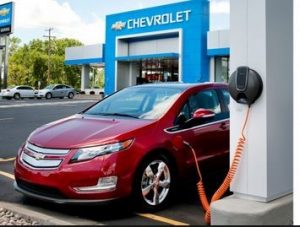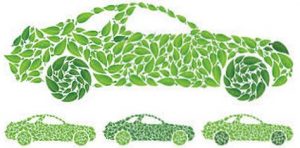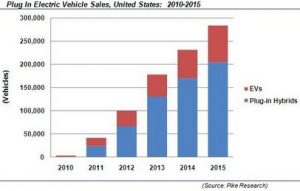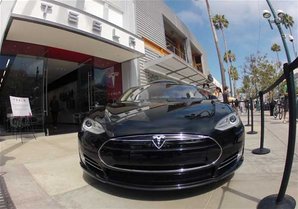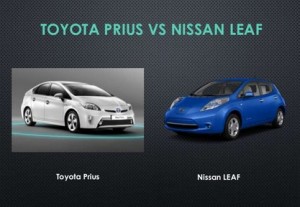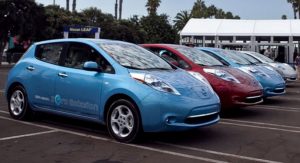 If you look at U.S. green car sales numbers, you’ll notice that the Nissan Leaf is down considerably – while others, including arch-competitor Chevrolet Volt – are up noticeably lately. The Leaf isn’t the only plug-in seeing declines in U.S sales. The BMW i3 has dropped way down this year, and Ford has announced that the Ford C-Max hybrid and plug-in hybrid will be vanishing in 2018.
If you look at U.S. green car sales numbers, you’ll notice that the Nissan Leaf is down considerably – while others, including arch-competitor Chevrolet Volt – are up noticeably lately. The Leaf isn’t the only plug-in seeing declines in U.S sales. The BMW i3 has dropped way down this year, and Ford has announced that the Ford C-Max hybrid and plug-in hybrid will be vanishing in 2018.
What’s behind it? Here are a few points to consider on the state of plug-in sales in the U.S……….
- Overall plug-in electric vehicle sales were up in February over the previous month and the previous year. Tesla Motors is behind much of that increase with Model S and the Model X, and the redesigned Chevrolet Volt has been seeing increases in recent months after a long period of sales declines.
- A period of change for the Leaf: Not long ago, the Nissan Leaf was seeing sales in the high 2000s to low 3000s, and was by far the best-selling electric car in the world; but sales dropped down in 2015 and into 2016. The Leaf sold only 930 units in the U.S. in February 2016, down 22.4% from February 2015. A new study by IHS cites the obvious reasons the Leaf has been seeing declines: cheap gasoline prices; increasing efficiency of conventional engine vehicles; and buyers’ waiting for the redesigned new model-year version of the Leaf that’s coming up, and other new electric vehicles that will be rolling out.
- Driving range may be part of it: While the 2016 Leaf in the SV and SL trims were put on the market in November with range increasing from 84 miles per charge to 107 miles per charge, Leaf sales didn’t go up. The “200 mile range” factor may be hurting Leaf sales. The Chevrolet Bolt was shown off at the Consumer Electronics Show in January with the announcement that the price competitive 200-mile range Bolt will be available by the end of this year. There’s also been a lot of interest in the Tesla Model 3 coming out in 2017 with a competitive starting price around $35,000 and more than 200 miles per charge. Tesla will have an unveiling of the Model 3 by the end of this month with more details on its availability and features released. Nissan hasn’t revealed details on the range of the redesigned 2017 Leaf. In 2014, Andy Palmer, who was then executive vice president and Nissan’s spokesman for the Leaf, said that the refreshed 2017 model would be going at least 186 miles on a charge to keep up with competitors.
- Nissan will be releasing details soon: Nissan has been quiet about the refreshed Leaf, but it’s expected to be announced soon – perhaps at the New York International Auto Show in April with sales starting in October. It could be later, such as sometime in 2018. There’s also been speculation that the Next-generation Leaf will arrive right after Nissan’s Power 88 business plan, which ends March 31, 2017. It will probably be tied to new battery chemistry for Nissan and Infiniti that should be ready by early 2017. An Infiniti luxury EV is on track for a 2017 debut; and the Leaf and an Infiniti EV may share the same battery technology.
- Leaf may look a little bit different: The Nissan Leaf will probably continue to have a hatchback layout, but with a more mainstream design. That’s the engineering and design direction Chevrolet took with the 2016 Volt and that Toyota adopted with the 2016 Prius. The new Volt doesn’t stand out as much on the street as the previous versions did and looks more like competitors, such as the Hyundai Sonata. The 2016 Prius has had fixes, such as its exterior base being lifted off the ground to avoid scraping when exiting driveways; its rear window being more visible for drivers; and its look changing the most since it was launched in Japan in 1997. Automakers have been going in this direction in recent years with aerodynamics, fuel-efficiency, and lightweighting becoming more important. It’s harder to tell them apart. I’ve wondered if that may hurt brand loyalty for the Leaf and Volt, as both of them have stood out clearly on freeways, much like the Tesla Model S.
- Longevity of the Leaf: The Leaf has taken a bad rap over its relatively low resale value and range degradation of its battery. Both of these factors have been improved, with Kelley Blue Book recently commenting on resale values for the Leaf improving; and concern over the durability and performance of the Leaf battery waning. These problems do tend to linger in public perception, as the Chevrolet Volt and Fisker Karma experienced with their highly reported battery fires. The Tesla Model S went through that crisis as well, but the automaker did a much better job of dealing with it and reaffirming consumer confidence by adding its titanium underbody shield. There’s also a recall by Nissan that was just announced on about 47,000 2013-2015 model year Leafs that will look into braking performance in cold weather; the cars’ electronic brake booster may freeze, requiring the driver to exert more pressure on the brake pedal. Recalls aren’t necessarily a crisis for the vehicle if it’s handled promptly and professionally by dealers and OEMs.
- Limitations on dealer lots: The Chevrolet Volt has seen sales increases in recent months but hasn’t returned to its strongest monthly sales figures. The refreshed Volt is available in just a few states to accommodate the early rollout of 2017 model year in the spring of this year. Nissan launched the 2016 Leaf in October 2015 with a choice of two different battery sizes – 24kWh battery pack offering 84 miles of range and 30kWh pack with an EPA-rated range of 107 miles. That wasn’t enough to drive up sales. Nissan may be taking a more conservative approach by adding the extended range battery as an option only, and working on the new battery with nearly double the range for the 2017 or 2018 model year.
- What Ghosn thinks: Nissan CEO Carlos Ghosn and other company executives appear to be championing the Leaf, per usual; and the production process at the Smyrna, Tenn., plant has been about the same since the Leaf started being built there in 2013. Ghosn recently said that he thinks development of the charging infrastructure is a more important issue than battery range, but the company is still committed to leading the EV revolution.
- China may be more important than the U.S. market. Ghosn recently said that his company has high hopes for the China market. He thinks it will help that the Leaf is much cheaper than the Tesla Model S, and that pricing will be very important in that market to convince skeptical first-time car buyers that an electric car is the way to go. Nissan is likely spending more in the Chinese market on marketing campaigns. Marketing for the Leaf isn’t nearly as visible these days in U.S. as it was in the early days of 2011-to-2012. Nissan has been offering inexpensive lease deals, discounts, and a No Charge to Charge promo with free charging for two years in select markets. It will be interesting to see how Nissan markets the redesigned Leaf in the U.S. There’s also the possibility that the Chinese government may phase out subsidies for purchasing EVs, which would take some wind out of the sales of its growing EV market.
- What happened to the BMW i3? The BMW i3 has seen similar sales patterns as the Nissan Leaf. In December 2015, 1,422 units were sold in the U.S.; only 248 units were sold in the U.S. in February. The plug-in hybrid variant of the BMW X5 crossover utility vehicle did better – with 345 units sold in February in the U.S., versus 248 for the electric-only i3. The BMW i8 has dropped out of the top 10 in U.S EV sales. The honeymoon may be over for the i Series plug-ins, and BMW may not be that committed to selling them in marketing campaigns, incentives, and dealer programs. BMW did cross the 50,000 sales unit mark for the i Series in January. The i3 was launched in Germany in September 2013 and the i8 in June 2014. They were sent to global markets like the U.S. soon after their launches. BMW isn’t backing away from supporting the i3 and i8, but it appears to need even more support in this phase of declining interest in overall EV sales by consumers and fleets. BMW may be adding i5 to its i Series plus-in vehicles, with a lightweight carbon-fiber body, but the automaker hasn’t yet confirmed whether that will be added to its product offerings.
 Ford changes gears on C-Max series: It was surprising to hear that Ford will be killing off the Ford C-Max Hybrid and C-Max Energi plug-in hybrid models in 2018. Sales numbers haven’t been strong enough for Ford to stay committed to the relatively new crossover hatchback models. AutoForecast Solutions reports that Ford will end production of the C-Max at its Wayne, Mich., assembly plant in 2018. Ford will make room at that plant for the Ford Ranger, which has been made in Thailand, to compete with GM’s smaller trucks. In February, Ford had strong overall sales – except for the C-Max and the largely discontinued E-series van – which were the only two models that saw sales declines during that month.
Ford changes gears on C-Max series: It was surprising to hear that Ford will be killing off the Ford C-Max Hybrid and C-Max Energi plug-in hybrid models in 2018. Sales numbers haven’t been strong enough for Ford to stay committed to the relatively new crossover hatchback models. AutoForecast Solutions reports that Ford will end production of the C-Max at its Wayne, Mich., assembly plant in 2018. Ford will make room at that plant for the Ford Ranger, which has been made in Thailand, to compete with GM’s smaller trucks. In February, Ford had strong overall sales – except for the C-Max and the largely discontinued E-series van – which were the only two models that saw sales declines during that month.
- What happened to the C-Max?: When the C-Max was launched in the fall of 2012, it looked very good as a direct competitor with the Toyota Prius. The C-Max Hybrid sold 19,162 units in the U.S. in 2015; it was number 14 in December hybrid sales, and it used to be in the middle of the top 10. Ford sold 8,433 C-Max Energi units in 2015. It was number nine in plug-in sales for December, lower down on the list than it has previously been. The C-Max Hybrid was down 26% in 2015 in U.S. sales compared to 2014, and the Energi plug-in hybrid was down 10%. As for competing with the Prius, Toyota has been down in Prius sales as well with dropping gas prices hurting sales; but Toyota is still committed to the Prius brand, rolling out the refreshed version in late 2015 as a 2016 model, and stating its commitment to keeping it in production. Ford quickly lost interest and commitment to the C-Max.
- Fusion may be the winner: During February, the Nissan Leaf ended up in fourth place right behind the Ford Fusion Energi plug-in hybrid on the U.S. plug-in sales list. It appears that Ford may be sticking with the Fusion Hybrid and Fusion Energi. The midsize sedan has done consistently well in its sales position on the U.S. market for hybrid and plug-in sales. The Ford Focus Electric, a battery electric model, may be getting more internal support from Ford, along with the Fusion, than the C-Max has received. That’s a real shame. I was thinking of buying a C-Max Energi. I’ve been looking for a cost-competitive plug-in hybrid with a utilitarian design ideal for transporting goods, such as helping somebody move or taking my surfboard to the beach. It wasn’t that long ago that plug-in hybrids were assumed to be the best way to go in the U.S. market with range anxiety being a big concern for reaching Americans who put a lot of miles on their cars each year. It’s become more difficult to discern the best route to take for creating improving sales in the U.S. and overseas markets. The Nissan Leaf had been beating the Chevrolet Volt and Toyota Prius Plug-in, and the all-battery Tesla Model S grabbed that position in the EV race over the past year. Auto analysts do expect automakers to stay committed, overall, to rolling out more plug-in models in the next few years – to meet national fuel economy and emissions guidelines; with expectations that gasoline prices will eventually creep back up; and assuming that consumers and fleets do expect to have a long list of hybrid and EV models to choose from.

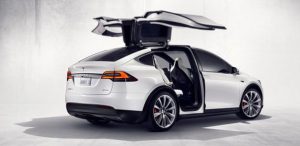 EV and hybrid sales: Plug-in electric vehicle sales were up substantially month-over-month and year-over-year – 17% over January and 6.7% over February 2014. The Tesla Model S, Chevrolet Volt, and Ford Fusion Energi saw sizable gains over last year, while the Nissan Leaf was down 22.4%.The Nissan Leaf has been declining in its position as the clear market leader, coming in fourth place for the first time, narrowly behind the Ford Fusion Energi plug-in hybrid. Tesla is continuing to take the lead in overall electric vehicle sales, with the Model S far ahead of the Chevrolet Volt and Nissan Leaf – and the recently launched Model X seeing a 25% increase in sales over January 2016. Hybrids continue to be hurt by low gasoline prices, declining to 1.8% of overall market share when it was in the 2.5% range for a long time. Sales were down nearly 10% since last year.
EV and hybrid sales: Plug-in electric vehicle sales were up substantially month-over-month and year-over-year – 17% over January and 6.7% over February 2014. The Tesla Model S, Chevrolet Volt, and Ford Fusion Energi saw sizable gains over last year, while the Nissan Leaf was down 22.4%.The Nissan Leaf has been declining in its position as the clear market leader, coming in fourth place for the first time, narrowly behind the Ford Fusion Energi plug-in hybrid. Tesla is continuing to take the lead in overall electric vehicle sales, with the Model S far ahead of the Chevrolet Volt and Nissan Leaf – and the recently launched Model X seeing a 25% increase in sales over January 2016. Hybrids continue to be hurt by low gasoline prices, declining to 1.8% of overall market share when it was in the 2.5% range for a long time. Sales were down nearly 10% since last year.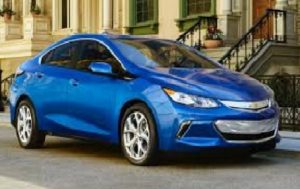 January EV sales: Plug-in electric vehicle sales saw the typical downturn pattern for the month of January. Winter Storm Jonas, which closed parts of the Eastern Seaboard for several days, has meant that less car shoppers have visited dealerships. With 2015 down slightly from 2014 in overall EV sales, January didn’t start this new year on a strong note. The
January EV sales: Plug-in electric vehicle sales saw the typical downturn pattern for the month of January. Winter Storm Jonas, which closed parts of the Eastern Seaboard for several days, has meant that less car shoppers have visited dealerships. With 2015 down slightly from 2014 in overall EV sales, January didn’t start this new year on a strong note. The 